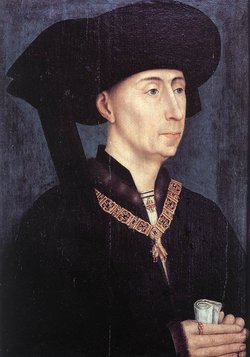Roger van der Weyden
|
|
Weyden_Deposition.jpg
Rog(i)er van der Weyden, also known as Roger de la Pasture, Rogier de Bruxelles, (c. 1400 - June 18, 1464) was a Flemish painter.
Life
He was born at Tournai, where in 1427 he entered the studio of Robert Campin, previously known as the Master of Flemalle.
He established himself in Brussels about 1435. He was in Italy in 1440-1450, but his visit shows no result on his style, which owes nothing to Italian models; and he returned to Brussels, where he died.
Works
His vigorous, subtle and expressive painting and popular religious conceptions had considerable influence on the art of Flanders and Germany. His great family portrait in the Ufizzi Gallery in Florence had an important influence on the spread of oil painting into Italy in the late 15th century. He did not study with Jan van Eyck, his older colleague who perfected the art of oil painting during Roger's lifetime. His style differs from van Eyck's in its direct emotionality and his sometimes melodramatic composition. But his handling of paint emulates van Eyck's subtle, jewel-like perfection. Unlike other Flemish masters, Roger used little underdrawing for his oil paintings, only blocking out the positions of the major elements in the composition. Hans Memling was his greatest pupil.
His principal paintings were:
- Descent from the Cross (1440), Madrid
- Descent from the Cross (1443), Sint-Pieterskerk, Leuven, Belgium
- triptych (1438-1440), Berlin Museum
- Madonna with Saints (1450), Stadel Institute, Frankfurt
- Last Judgment (1451), hospital of Beaune, France
- portrait of Philip the Good (c. 1456-1458), Koninklijk Museum voor Schone Kunsten, Antwerp
- portrait of Charles the Bold (c. 1456-1458), Royal Museums of Fine Arts, Brussels
- the Altar-piece of St John, Berlin Museum
- the triptych from Middelburg, Berlin Museum
- Entombment of Christ, National Gallery, London
- Woman Crying, Royal Museums of Fine Arts, Brussels
- Descent from the Cross, Louvre, Paris
- Adoration of the Magi, Old Pinakothek, Munich
- Descent from the Cross, the Hague
- Seven Sacraments, Koninklijk Museum voor Schone Kunsten, Antwerp
- Descent from the Cross, Royal Museums of Fine Arts, Brussels
Some of these latter, and others, are only doubtfully attributed to the master. The Crucifixion in the Royal Museums of Fine Arts, Brussels, assigned either to him or to Memling, and containing portraits of the Sforzas, probably represents Roger van der Weyden in some of the principal figures at least, though Memling may have completed the picture.
Weyden_Ivo.jpg
There was a younger Roger van der Weyden (c. 1450-1529), to whom a brilliant Mary Magdalen in the National Gallery is attributed.
See also
==

